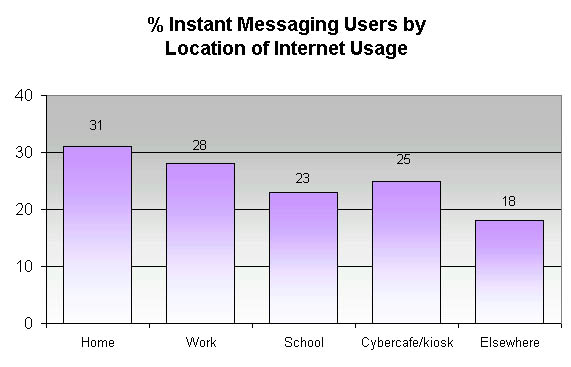
Instant Messaging Users in Latin America
Instant messaging (IM) is a system by which Internet users can interact with other users. In the beginning, instant messaging was introduced within internet service providers. Lately, interoperability among different systems have enabled people to interact with tools such as ICQ, Yahoo! Messenger, AIM and so on across systems. While running an instant messaging system, a user can check the list of 'friends' (the so-called 'buddy' list), see who is currently online/offline and exchange messages in an instant.
As a technology, instant messaging is obviously a system that has network externalities. That is to say, the utility of the system grows with the number of users. After all, there is no point in being the only person to have that technology because there would not be anyone else to exchange messages with. As more of one's friends and business associates adopt this technology, the more useful it becomes. It has also become a popular social outlet to find other users according to general characteristics such as age, gender, personal interests and profiles and even moods of the moment.
We will now cite some data from the TGI Latina study. This is a survey of persons between the ages of 12 to 64 years old in eight Latin American countries (Argentina, Brazil, Chile, Colombia, Mexico, Panama, Peru and Venezuela) conducted during the year 2001. Of the nearly 50,000 survey respondents, there were 3,147 who said that they had used the Internet within the last 30 days. Within these Internet users, 27% of them said that they had used instant messaging in the last 30 days.
In the next table, we show the breakdown of instant messaging users by age/sex. The level of usage is higher among younger men and women.

In the next table, we show the breakdown of instant messaging users by their recency and frequency of internet usage. As we expect, the more recent/frequent internet users are more likely to be using instant messaging. After all, if one gets on the Internet once a week for a few minutes, there is not much point in being involved with a near-real-time system because one is offline most of the time.

Instant messaging began as an adjunct tool for consumers to communicate and entertain. Its initial presence at the workplace was in fact scoffed at due to its apparently negative impact on worker productivity. This would be the case if instant messaging was used as a chat device, with a sleazy reputation as a place of encounter for cyberhackers, teenage adolescents and/or cybersex practitioners. Notwithstanding the attitudes by IT and MIS management, instant messaging has gradually crept into the workplace because it has proved to offer effectiveness and efficiencies that compliment those of telephony and electronic mail.
On one hand, telephone calls often end up being routed to voice mail nowadays. On the other hand, e-mail is unidirectional and there may not be any feedback as to where the recipient might have read it or even available. Instant messaging enables one to ascertain whether the addressee is available and it demands less than the total attention that a telephone call requires. Since the communication is a text message, it is required to be terse and to the point. Instant messaging systems also have the capability of involving multiple parties in a conference.
The next table shows the use of instant messaging by location of internet usage. Presently, home usage still exceeds work usage. One of the barriers is that there are some security issues with instant message systems, which are of significant concern in the business environment.

REFERENCE
(posted by Roland Soong, 3/7/2002)
(Return to Zona Latina's Home Page)